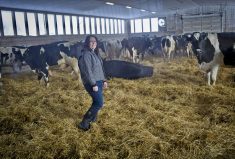Here is some of what some KAP members said about this year’s production during their online advisory council meeting Oct. 20:
District 1, Carter McKinney
“I heard of guys who got moderate yields on some crops and some guys got basically zero so it’s kind of hard to tell. I think it had to do with spotty rainfall that came through the area and the type of soil.”
District 2 (submitted report)
Yields were highly variable.
Some canola was over 40 bushels an acre, but most was 25 to 35 and 10 to 15 in drier areas.
Read Also

Still hard to predict precise fertilizer payback
Despite decades of advances, international research finds no clear answer for where and when adding nutrient will fail to boost growth.
Wheat yields were average to above average at 50 to 70 bushels an acre.
Oats, 60 to 120, barley 40 to 120, soybeans, 25 to 50.
Late rains helped plump up corn kernels.
Sunflower yields average to above average.
Dry beans have been average to well below average depending on seeding dates.
Late rains helped with cattle feed and extended the grazing season.
Fertilizer prices are skyrocketing and supply at this point is not guaranteed.
District 3, Butch Harder
“District 3 includes Winkler, Morden and Roland and they probably had one of the worst crops they have ever had. In our particular area (Lowe Farm) it wasn’t too bad…
“North of me five miles, five-bushels-an-acre canola. On our farm we averaged 35, which is good. Soybeans were kind of 60-40. Wheat was pretty good, especially the early-seeded wheat… the oats weren’t so good.”
District 6, Chuck Fossay
“All the yields were poor, but there’s a lot of variability…
“Wheat, barley, canola, typically was in the 60 to 70 per cent of average yields. There were areas where it was less than that.
“Oats I think in general were pretty poor. I know farmers who had their crops written off and I had a few neighbours who managed to harvest 80 to 100 bushels (an acre), but a lot of thins, very poor quality, low test weight.
“Canola — I am hearing yields of anywhere from lows of two or three bushels to highs of maybe 20 bushels (an acre) on average.
“To the north of me in the Woodlands RM again a lot of poor crops.
“The shortage of hay is very concerning up there. Pasture conditions were very poor.
“One item that I am just starting to hear about is a shortage of fertilizer. We all know fertilizer prices are high.
“The (anhydrous ammonia) dealers have basically a limit to how much they are able to sell and in many cases they have committed their product to their regular customers and anybody who comes in for a few tanks… they aren’t able to get any anhydrous at this time.”
District 8, George Graham
“I guess we had a couple of decent rains in June so our crops were average.
“Cereals did quite well. Flowering crops — flax, canola — they got blasted with the heat so those yields were down probably 30 or 40 per cent from previous years.”
Graham said because the district has some canola supplies, buyers are aggressively seeking it.
“Yorkton crushers are already offering $1 to $1.50 a bushel more than Bunge is offering right now.”
Soil moisture is poor
“Fertilizer is going on, but my God the price you’re paying is incredible and supplies are starting to dwindle.”
District 9, Neil Galbraith
The eastern part of the district including Gladstone and Plumas were very dry with very poor crop yields and were short of hay, he said.
“And Minnedosa and west we were actually very fortunate. We got a few rains in June and one in July that brought an average grain crop… except for canola… but cereals and pulses, peas and soybeans were average, and the hay yields were average as well. There is not a hay shortage in the area for beef producers.”
District 10 (submitted report)
Moisture is varied across the north Interlake with many areas receiving four to six inches in late August to early September.
South Interlake missed the big rains and received about half of the north.
Pastures are in good shape but purchasing winter feed is a large financial burden.
AgriRecovery has helped but there are many cow-calf producers still looking for straw or hay and we still expect to see a drawdown in breeding animals in this region.
Canola yields — three to 20 bushels an acre.
Wheat yields are about half a crop or less.
Flax, barley, oats are all a disappointment, but some growers managed an average alfalfa and trefoil seed yield.
District 11, Andrew Melnychenko
“Our district I would say overall did OK. Definitely less than average but not as poor as some areas.”
Manitoba Beekeepers Association, Paul Gregory
“Honey yields are anywhere from half to two-thirds of an average crop. Some places around Swan River and farther west did quite well, but on average it was a poor year. Honey prices have gone up $1 a pound. It’s incredible. I never did think we’d see these prices…”
Gregory thanked grain producers for spraying crops responsibly limiting bee losses.
Manitoba Seed Growers Association, Jake Ayre
“I would say just contact your local seed grower earlier rather than later. Personally I am not concerned about supply.”
Keystone Potato Growers Association Inc., Dan Sawatzky
Yields haven’t been all calculated, but it looks like a slightly bigger crop than last year, he said.
“Carman-Winkler in particular are a little bit short because they ran short of water.
“The potato industry is handcuffed in some ways because of the lack of available water. We’ve had to contract and source potatoes from outside of the province this year. Hopefully we won’t have that situation continue, but the only way to rectify that is to look at additional water development.”
Manitoba Oat Growers Association, Bob Lepischak
Yields are down 25 to 35 per cent, he said.
“Weight, remarkably, remained good because the thins seemed to blow through the combine.
“Prices are absolutely robust. It’s something unprecedented.”
Manitoba Pulse & Soybean Growers, Daryl Domitruk
“Generally speaking the low yields are what we had predicted, but the upper end of the yields, there were many more 30s, 40s and 50s (bushels an acre) than we had expected and that’s owing to soybeans’ particular sensitivity to an August rain and it doesn’t seem to matter how much rain you get in August, even small amounts seem to make a difference in yield.
“In the last couple of years Manitoba has become the leader in dry bean production in Canada in that we have exceeded Ontario and so we want to make investments so we are able to maintain that position.”
Dairy Farmers of Manitoba, Stefan Signer
August rain really helped hay supplies, he said.
“On many farms their third cut was their best cut this year.
“General reports are corn silage is slightly below average tonnage-wise but the tonnage tends to be great quality because those plants put on a bit more cob and filled the kernels.
“Good dairy-quality hay tends to be trading in the 15-cent (a pound) range, which is very high, but there is some available and it’s not the case that every bale is immediately snapped up anymore.”
















